The TYAN Transport HX TN83-B8251 is a PCIe Gen4-compatible server designed for high-performance computing and GPGPU (that is, general-purpose computing on graphics processing units) environments. Though it resides inside 2U chassis, this server is designed to be pretty flexible from a storage and GPU standpoint. Because this is also an AMD-based system, it can support PCIe 4.0 components, though only in slots at the back of the server.
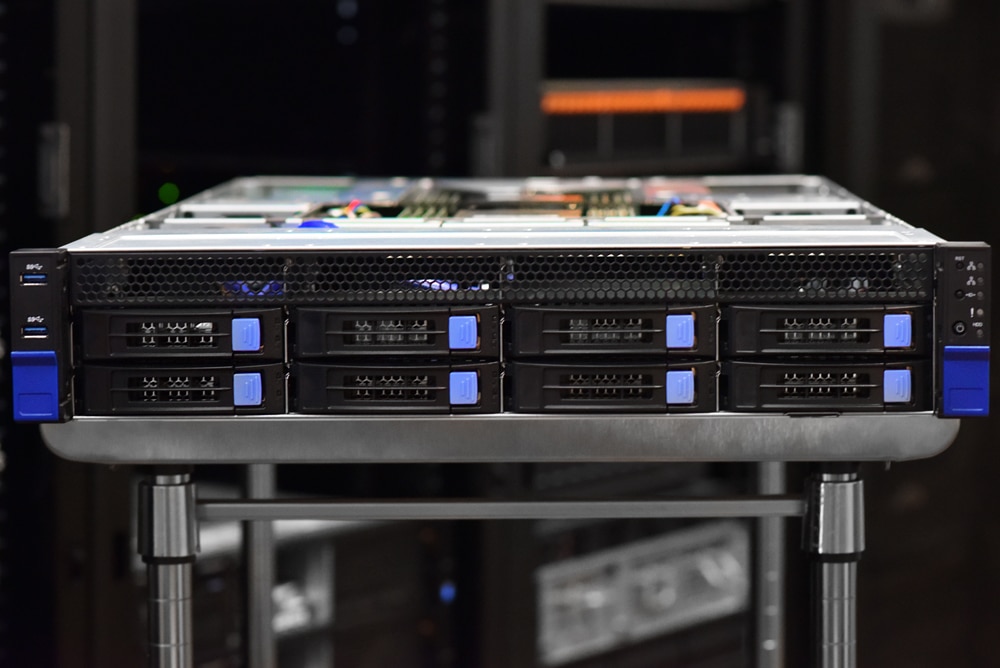
The TN83-B8251 is a unique server. Though it features multi-GPU support, it has a limited range of CPU offerings available due to its restrictions in system cooling. As a result, users will only have CPUs with lower thermal design power to choose from. The TN83-B8251 supports dual-socket AMD EPYC 7002 CPUs, has eight DIMM slots available per CPU for a possible total of 2TB DDR4 RAM (ECC RDIMM/RDIMM 3DS/LRDIMM/LRDIMM 3DS 3200), two 10GbE ports, and a GbE port that is dedicated for IPMI. It also comes equipped with five USB 3.1 Gen1 ports, including one with Type-A connectivity.
We were shipped with an eight 3.5-inch bay configuration, which houses both SATA and NVMe drives. Our build includes 512GB of DDR4 3200MHz DRAM (utilizing all 16 DIMMs with 32GB sticks in each), dual AMD EPYC 7F32 8-Core Processors, and 4 of the Micron 9300 NVMe SSDs that we test in our other platforms.
TYAN Transport HX TN83-B8251 Specifications
| System | Form Factor | 2U Rackmount | |
| Chassis Model | TN83 | ||
| Dimension (D x W x H) | 32.71″ x 17.25″ x 3.43″ (831 x 438.4 x 87mm) | ||
| Motherboard Name | S8251GM2NE-2T# | ||
| Motherboard Notification | # The motherboard not sold separately | ||
| Gross Weight | 33.1 kg (73 lbs) | ||
| Net weight | 20.3 kg (44.8 lbs) | ||
| Front Panel | Buttons | (1) RST / (1) PWR w/ LED / (1) UID | |
| LEDs | (1) HDD / (2) LAN / (1) UID / (1) System Event | ||
| I/O Ports | (2) USB 3.1 Gen1 ports | ||
| External Drive Bay | Qty / Type | (8) 3.5/2.5″ Hot-swap SSD/HDDs | |
| HDD Backplane Support | SAS 12Gb/s /SATA 6Gb/s /NVMe | ||
| Supported HDD Interface | (8) SATA 6Gb/s / NVMe | ||
| Notification | The SAS/SATA HDD backplane is connected to the onboard SATA connection by default. Please contact Tyan technical support if a discrete SAS HBA/RAID adapter is required. | ||
| System Cooling Configuration | FAN | (5) 8cm fans | |
| Power Supply | Type | CRPS | |
| Input Range | AC 200-240V/12.6A | ||
| Frequency | 47-63 Hz | ||
| Output Watts | 2,200 Watts | ||
| Efficiency | PFC / 80 plus Platinum | ||
| Redundancy | 1+1 | ||
| Processor | Qty / Socket Type | (2) AMD Socket SP3 | |
| Supported CPU Series | (2) AMD EPYC™ 7002 Series Processors | ||
| Configurable Thermal Design Power (cTDP) Wattage | Max up to 200W | ||
| Memory | Supported DIMM Qty | (8)+(8) DIMM slots | |
| DIMM Type / Speed | DDR4 ECC RDIMM/RDIMM 3DS/LRDIMM/LRDIMM 3DS 3200 | ||
| Capacity | Up to 2,048GB RDIMM / 4,096GB LRDIMM 3DS | ||
| Memory channel | 8 Channels per CPU | ||
| Memory voltage | 1.2V | ||
| Expansion Slots | Pre-install TYAN Riser Card (PCI-E Gen4) |
(1) M8251T83-L32-4F riser card for (2) FH/FL PCI-E Gen4 x16 + (2) FH/FL PCI-E Gen4 x8 slots (left) * split by Mux. / (1) M8251T83-R32-4F riser card for (2) FH/FL PCI-E Gen4 x16 + (2) FH/FL PCI-E Gen4 x8 slots (right) * split by Mux. / (1) M8251T83-LR32-2L riser card for (1) HH/HL PCI-E Gen4 x16 (right) +(1) HH/HL PCI-E Gen4 x16 (left) slots | |
| Physical Dimensions | FH/FL (Full-height / Full-length): 4.4″ x 12.3″ (111.2 x 312mm) HH/ HL (Half-height / Half-length): 2.7″ x 6.6″ (68.9 x 167.7mm) FH/10.5”L (Full-height / 10.5” in length ): 4.4″ x 10.5″ (111.2 x 266.7mm) |
||
| LAN | Qty / Port | (2) 10GbE ports, (1) GbE port dedicated for IPMI | |
| Controller | Intel X550-AT2 | ||
| PHY | Realtek RTL8211E | ||
| Storage | SATA | Connector | (2) SATA-DOM / (8) SATA from (2) Slim SAS (8-ports) |
| Controller | Direct from AMD EPYC CPU | ||
| Speed | 6Gb/s | ||
| RAID | N/A | ||
| NVMe | Connector (Slim SAS) | (4) SFF-8654 for (8) NVMe ports | |
| Graphic | Connector type | D-Sub 15-pin | |
| Resolution | Up to 1920×1200 | ||
| Chipset | Aspeed AST2500 | ||
| I/O Ports | USB | (2) USB3.1 Gen1 ports (@ rear) / (2) USB3.1 Gen1 ports (via Cable) / (1) USB3.1 Gen1 port (Type-A) | |
| COM | (1) DB-9 port (COM1) + (1) header (COM2) | ||
| VGA | (1) D-Sub 15-pin port | ||
| RJ-45 | (2) 10GbE ports, (1) dedicated GbE for IPMI | ||
| SATA | (8) SATA from (2) Slim SAS connectors + (2) SATA-DOM connectors | ||
| TPM (Optional) | TPM Support | Please refer to our TPM supported list. | |
| System Monitoring | Chipset | Aspeed AST2500 | |
| Temperature | Monitors temperature for CPU & memory & system environment | ||
| Voltage | Monitors voltage for CPU, memory, chipset & power supply | ||
| LED | Over-temperature warning indicator / Fan & PSU fail LED indicator | ||
| Others | Watchdog timer support | ||
| Server Management | Onboard Chipset | Onboard Aspeed AST2500 | |
| AST2500 iKVM Feature | 24-bit high-quality video compression / Supports storage over IP and remote platform-flash / USB 2.0 virtual hub | ||
| AST2500 IPMI Feature | IPMI 2.0 compliant baseboard management controller (BMC) / 10/100/1000 Mb/s MAC interface | ||
| BIOS | Brand / ROM size | AMI / 32MB | |
| Feature | Hardware Monitor / SMBIOS 3.0/PnP/Wake on LAN / Boot from USB device/PXE via LAN/Storage / Console Redirection / ACPI 6.1 / ACPI sleeping states S0, S5 / FAN speed control automatic | ||
| Operating System | OS supported list | Please refer to our AVL support lists. |
TYAN Transport HX TN83-B8251 Design and build
The TYAN Transport HX TN83-B8251 has a really interesting and unique build. So, let’s get right into it the exterior functionality. On the left side of the server are a couple of USB 3.0 ports, while the status LED lights and power button reside on the right.
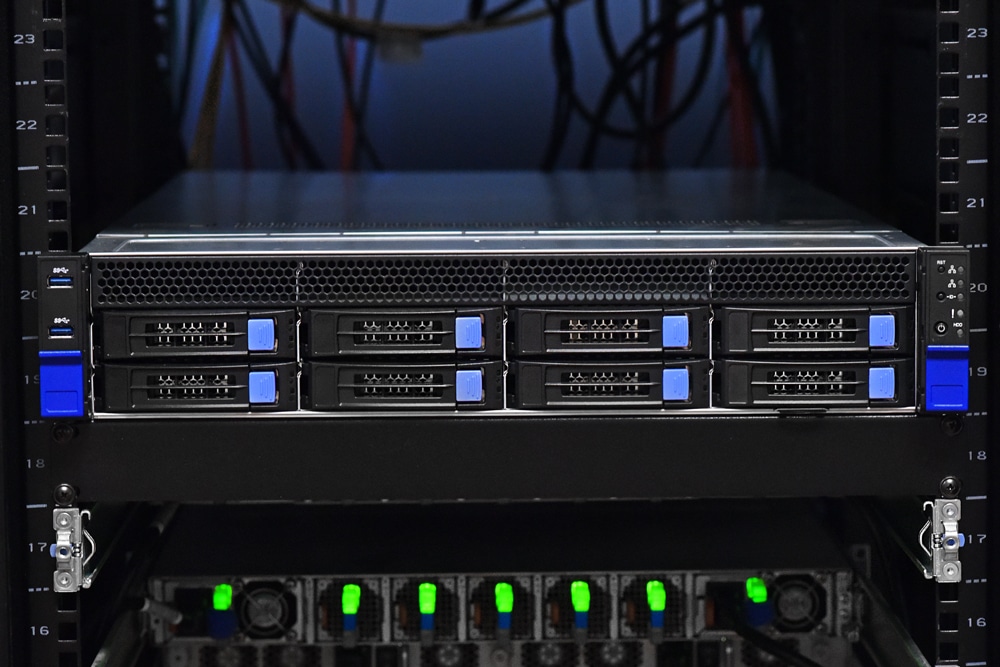
Removing the trays shows that they are set up for U.2 drives right out of the box; however, the side panel features a hinge mechanism that swings open, allowing users to easily drop in a hard drive from the side and lock them in. Once the pins secure the drive nicely into place, you can easily slide the drive back into the tray slot with a nice click.
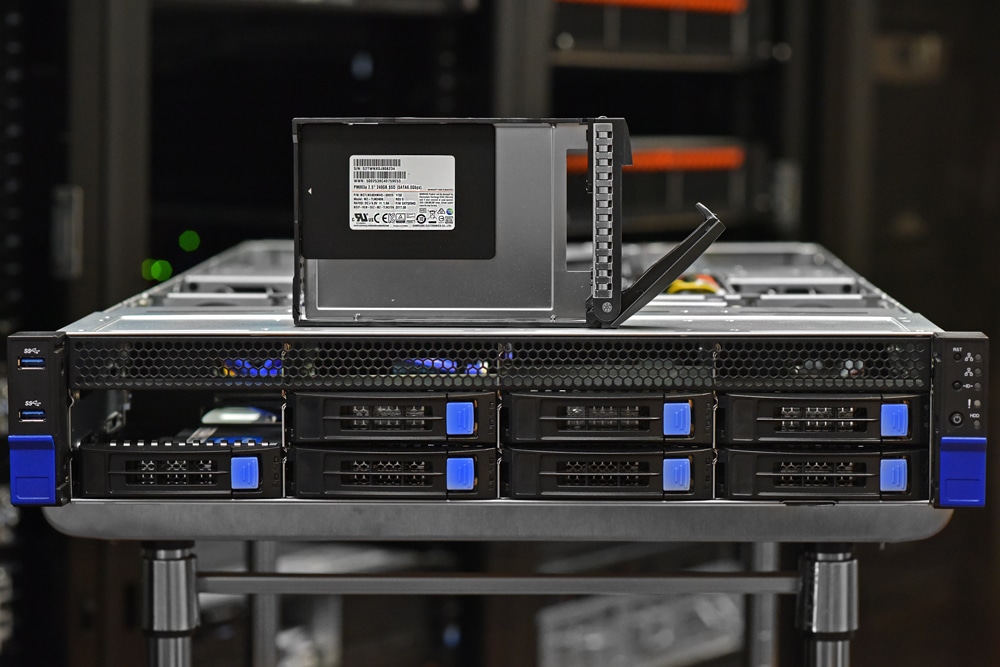
Moving on to the back panel reveals an interesting layout. Starting on the left and right sides are the 4×4 expansion slots. The server is designed mainly for GPUs, so these slots allow you to insert a total of 4 dual-width GPUs (i.e., NVIDIA Volta Tesla V100 GPUs) or 10 single-width GPUs. As a side note when unboxing the server, the expansion slot covers were shipped with foam protective sheets, which we think is a first for us.
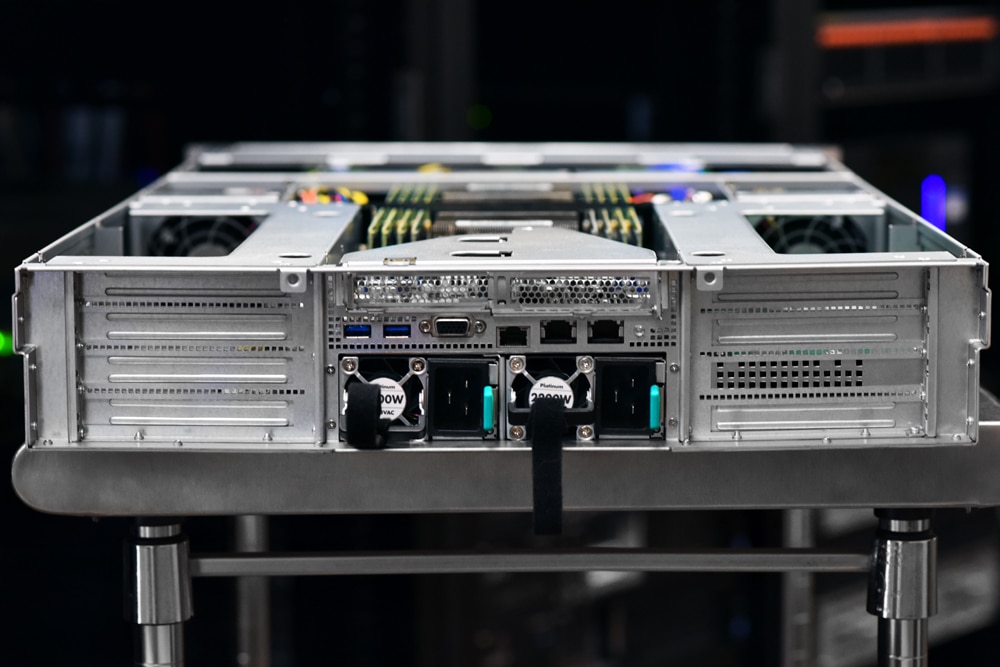
Also on the back are redundant power supplies in the middle, two USB ports, monitor and management ports, one 1GbE port, and two 10GbE ports. Overall, a really interesting setup, as these components are typically spread out along the back panel for servers instead of being all clustered in the center.
TYAN makes it very easy to open up the server lid. Simply pull in the two hinges on the top of the case and lift it up (you will have to use a screwdriver to open up the back panel of the server, however). Once everything is removed, you will see right away that all the components are set up through the middle of the server. Though we’ve seen these configurations before, that isn’t very common.
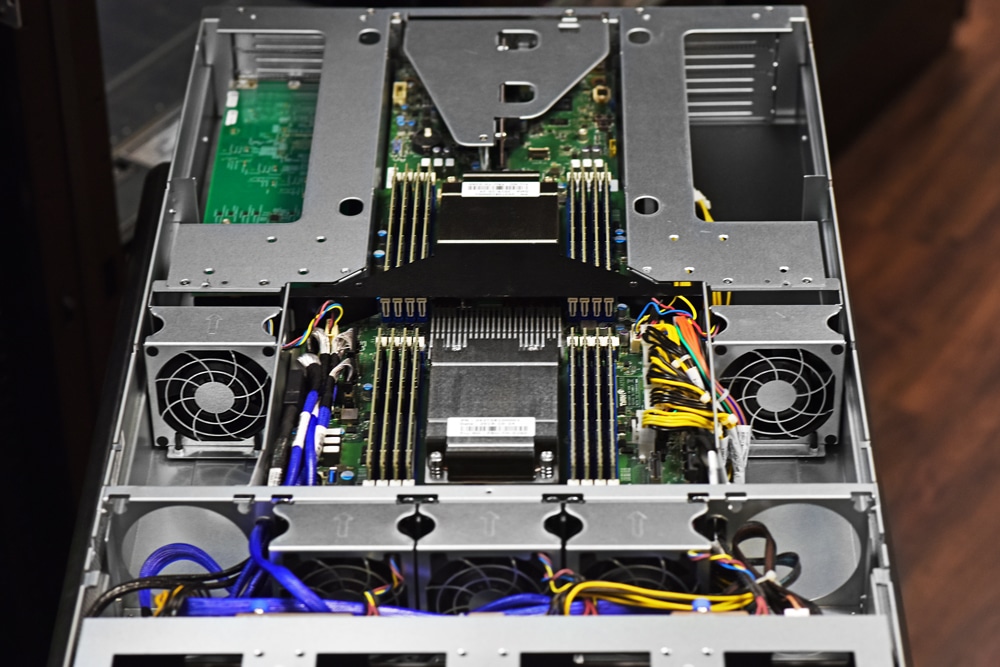
At the front is the backplane where the SATA and NVMe drives are installed. Next are the three 8cm fans, which are placed in the center, leaving open spots on the sides for two additional units. This is interesting because it is set up in a way that allows the GPUs (which are installed on the sides of the rear portion of the server) to get their own airflow due to metal dividers that surround the other components.
As we pull out the fans, we noticed that the main board of the server is elevated slightly on top of a riser. This forces the airflow over the main components, even though only a third of the fan is above the board.
Front and center are the dual-socket AMD CPU slots, with 8 DIMM slots per.
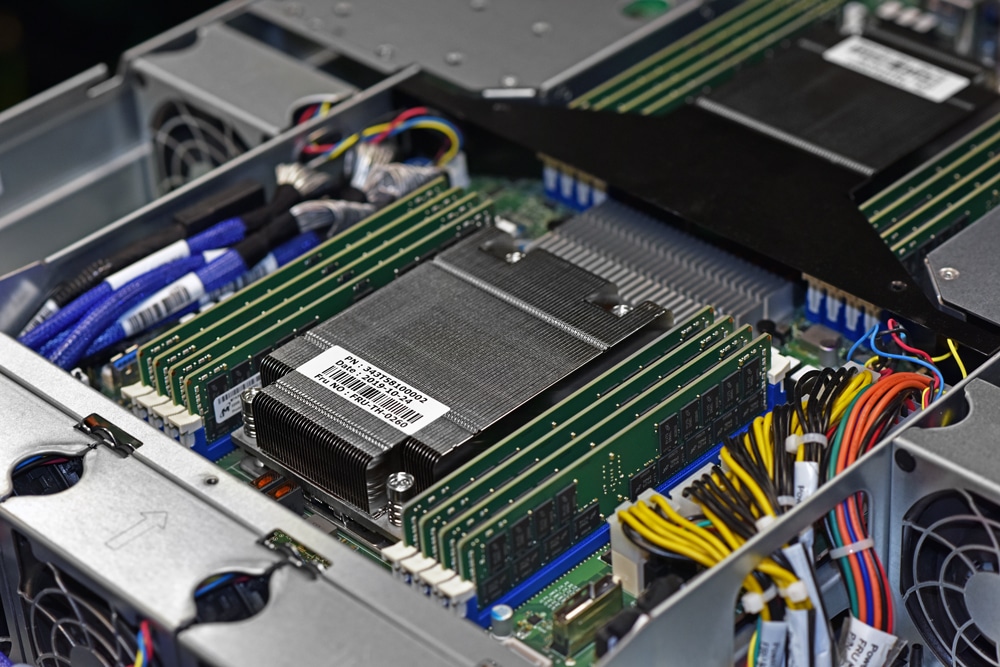
At the back is a riser for the two half-height GPU cards, along with the four possible half-height cards (NVIDIA Tesla T4) that can be installed on either side for a total of 10. You can also go the route of cards like V100s (double-wide), you will get two on each side in addition to the ones in the center. TYAN has also included external power cables for the high-power hungry GPUs, which are easily accessible at the back. This is a very welcomed feature, as most servers require users to both buy the cables and do the wiring themselves, which can be a pain. This only emphasizes that the server is primarily set up to favor GPUs.
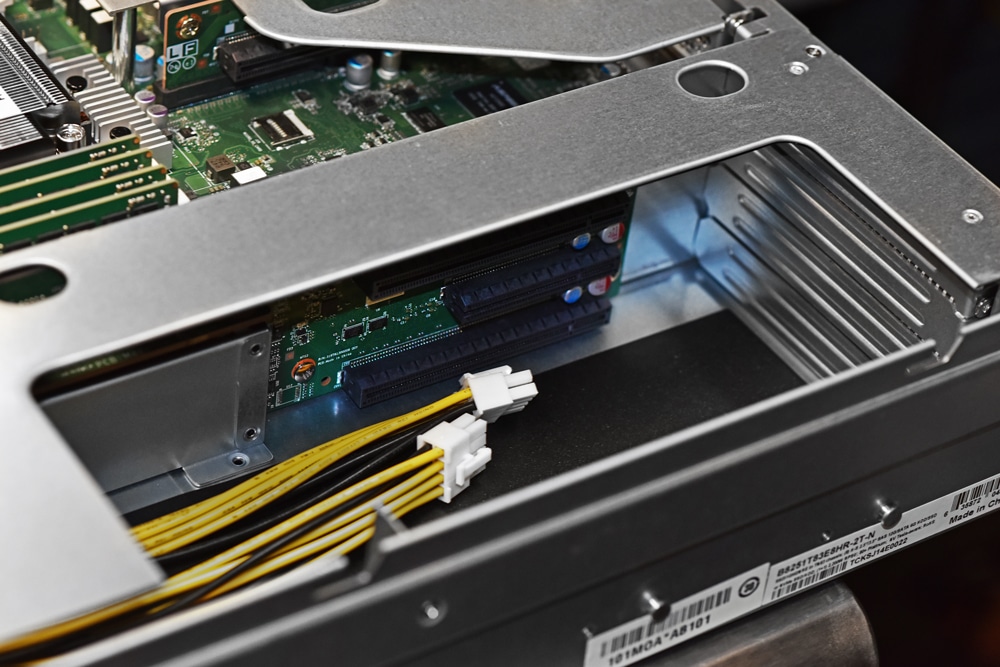
This GPU-focused design comes at the expense of storage, unfortunately. Because they went with the 3-and-half-inch build at the front of the chassis, you can only get eight drives in the TYAN server. You can get a decent amount of storage with HDDs as well as good performance with the U.2 NVMe drives, but it certainly wouldn’t be considered a very dense server. It would have been interesting if they added an M.2 slot either side of the front CPU, but we certainly understand its absence due to the specific use case of this GPU-heavy server. It’s just wishful thinking for a group of storage people.
TYAN Transport HX TN83-B8251 Performance
VDBench Workload Analysis
When it comes to benchmarking storage arrays, application testing is best, and synthetic testing comes in second place. While not a perfect representation of actual workloads, synthetic tests do help to baseline storage devices with a repeatability factor that makes it easy to do apples-to-apples comparison between competing solutions. These workloads offer a range of different testing profiles ranging from “four corners” tests, common database transfer size tests, as well as trace captures from different VDI environments. All of these tests leverage the common vdBench workload generator, with a scripting engine to automate and capture results over a large compute testing cluster. This allows us to repeat the same workloads across a wide range of storage devices, including flash arrays and individual storage devices.
Profiles:
- 4K Random Read: 100% Read, 128 threads, 0-120% iorate
- 4K Random Write: 100% Write, 64 threads, 0-120% iorate
- 64K Sequential Read: 100% Read, 16 threads, 0-120% iorate
- 64K Sequential Write: 100% Write, 8 threads, 0-120% iorate
- Synthetic Database: SQL and Oracle
- VDI Full Clone and Linked Clone Traces
With random 4K read, the TYAN Transport HX TN83-B8251 Server peaked at 2,439,387 IOPS with a latency of 200.5µs.
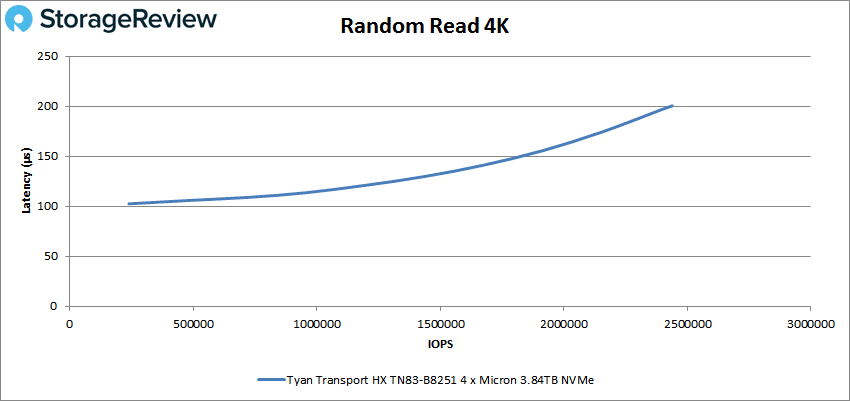
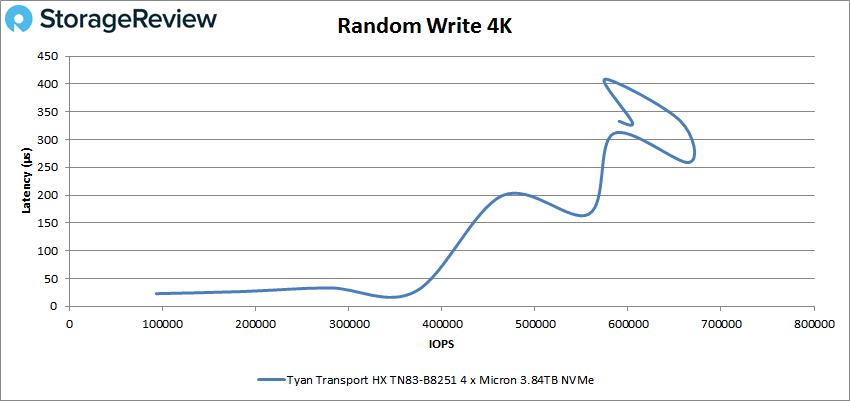
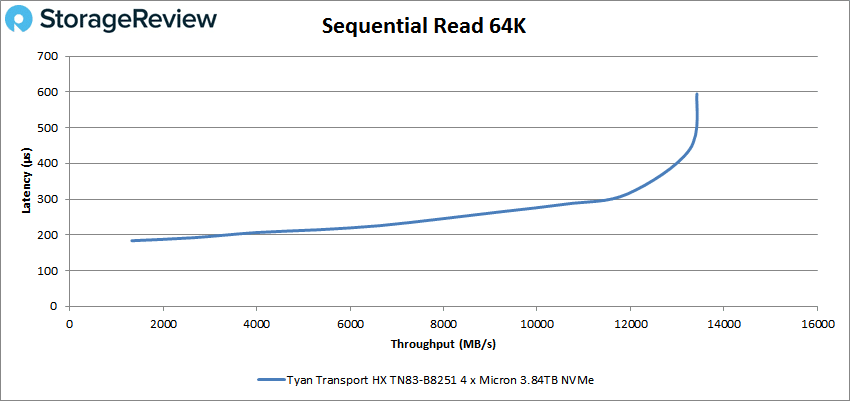
For 64K write, the server showed unstable results as the workload got heavier. Once the TYAN peaked at 63,373 IOPS (or 3.66GB/s) and 735.2µs, the performance took a significant hit.
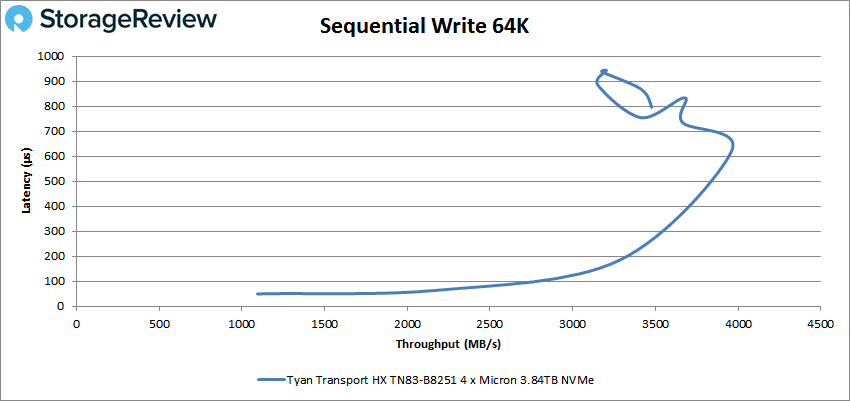
Our next set of tests are our SQL workloads: SQL, SQL 90-10, and SQL 80-20. Starting with SQL, the TYAN server saw a peak of 729,415 IOPS at a latency of 158.6µs.
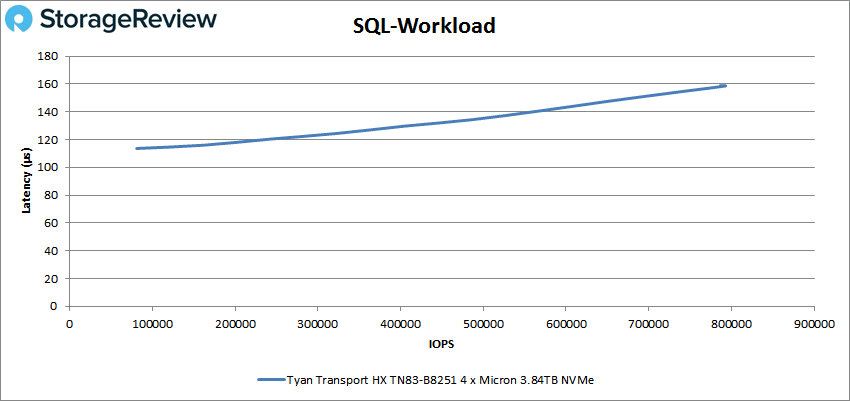
For SQL 90-10 the server peaked at 722,189 IOPS at 163.6µs for latency.
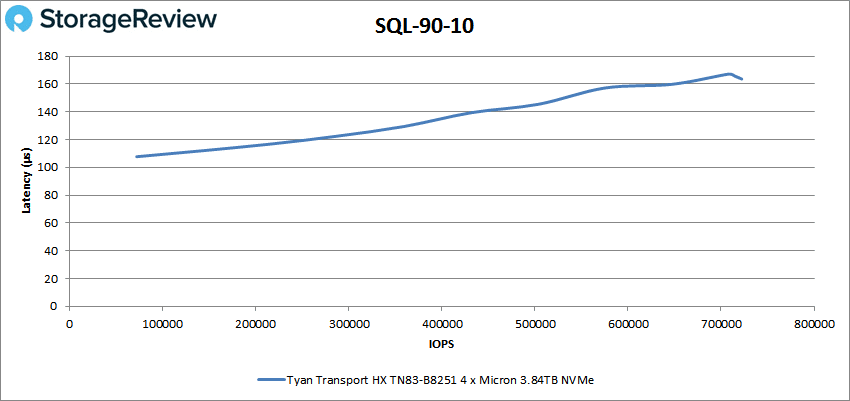
Moving on to SQL 80-20, the TYAN TN83-B8251 server saw a peak performance of 633,022 IOPS with a latency of 183.9µs.
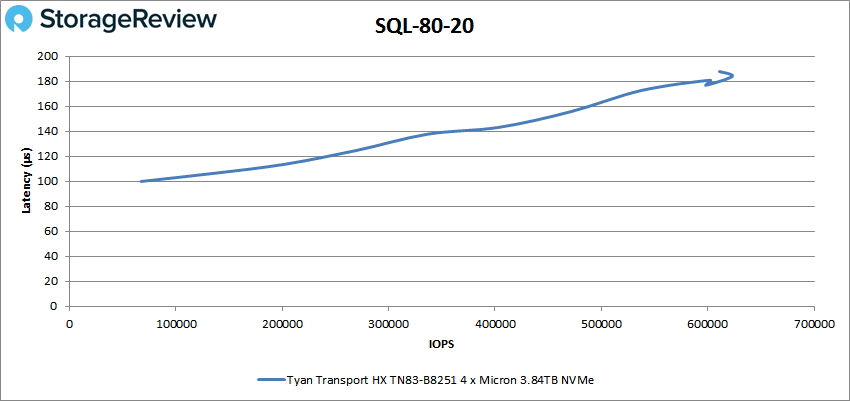
Next up are our Oracle workloads: Oracle, Oracle 90-10, and Oracle 80-20. Starting with Oracle, the TYAN server recorded a peak of 619,289 IOPS at a latency of 191.3µs before it had a slight dip performance at the very end.
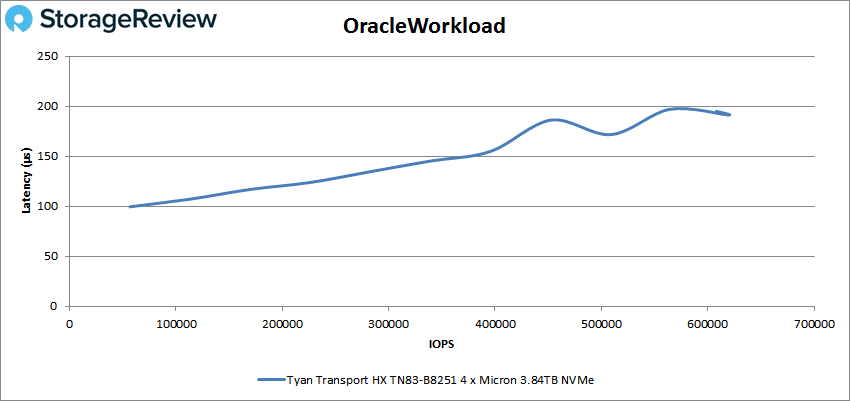
With Oracle 90-10, the TYAN server was able to peak at 601,746 IOPS at a latency of 142.2µs.
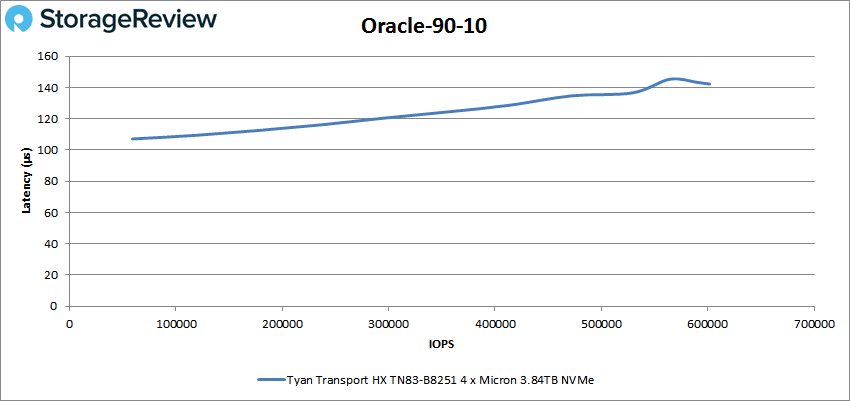
Oracle 80-20 gave the server a peak performance of 556,511 IOPS at a latency of 149.9µs.
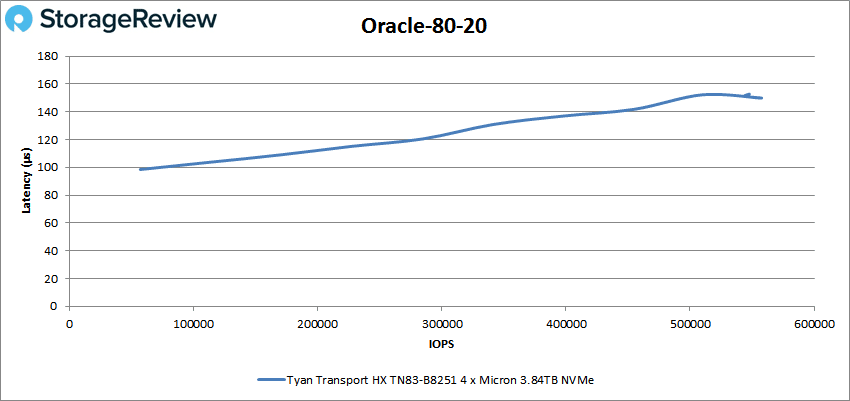
Next, we switched over to our VDI clone test, Full and Linked. For VDI Full Clone (FC) Boot, the TYAN server hit a peak of 587,491 IOPS with a latency of 208.8µs.
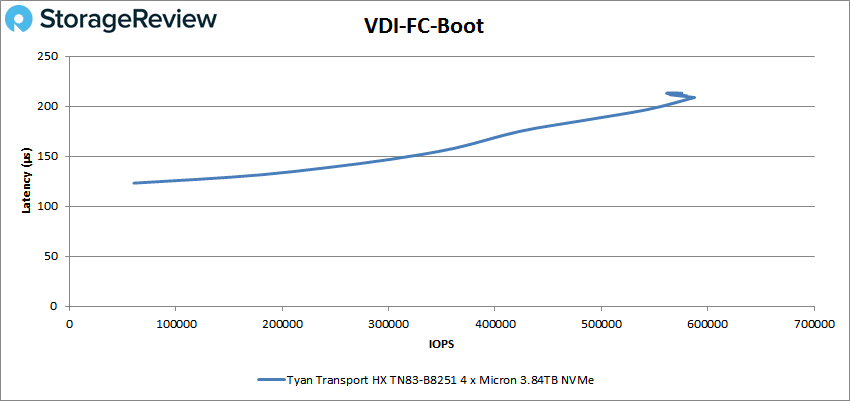
VDI FC Initial Login saw a peak of 160,280 IOPS with a latency of 518µs with a bit of instability at the end of the test.
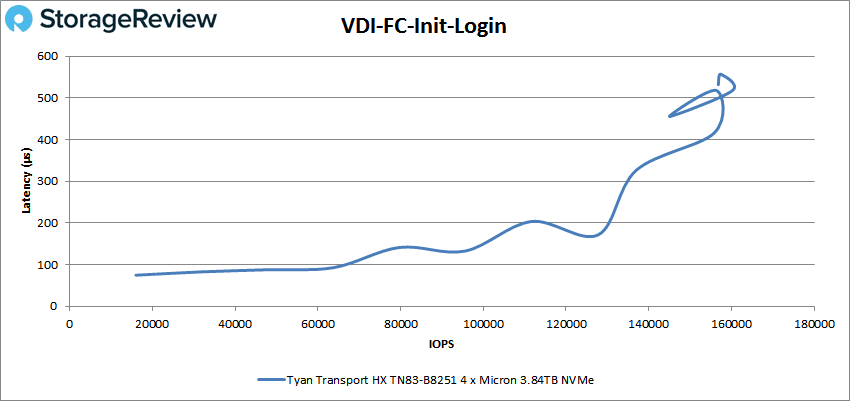
Next up is VDI FC Monday Login, which gave us giving us a peak of 149,382 IOPS and latency of 320.3µs.
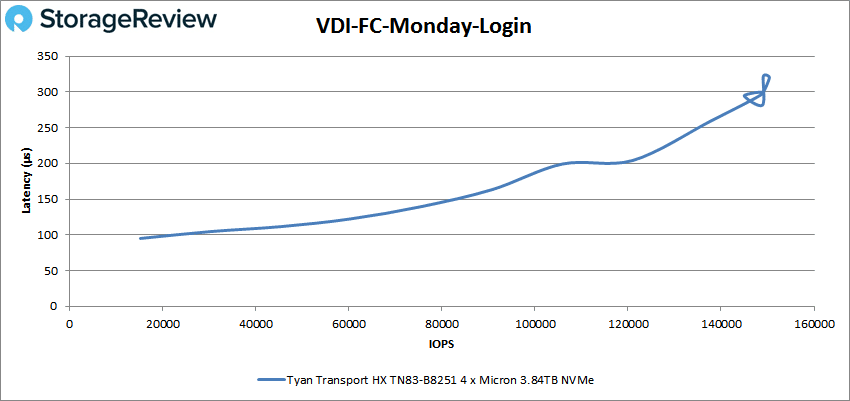
Switching to VDI Linked Clone (LC) Boot, the TYAN server showed a peak of 291,773 IOPS and a latency of 200.1µs.
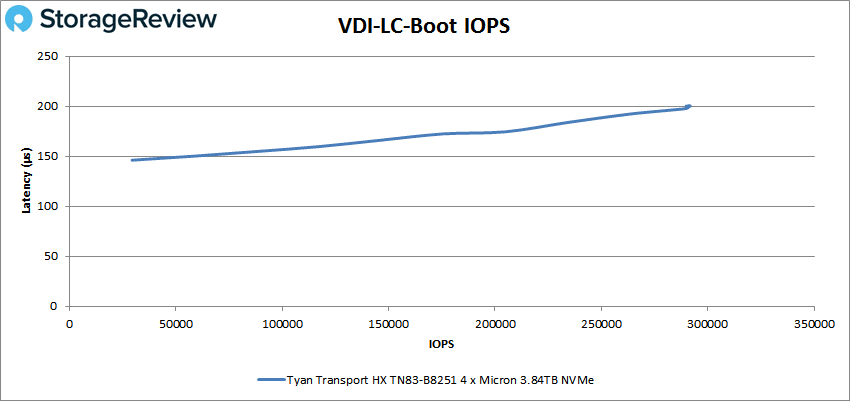
For VDI LC Initial Login the server peaked at 83,050 IOPS with a latency of 283.5µs.
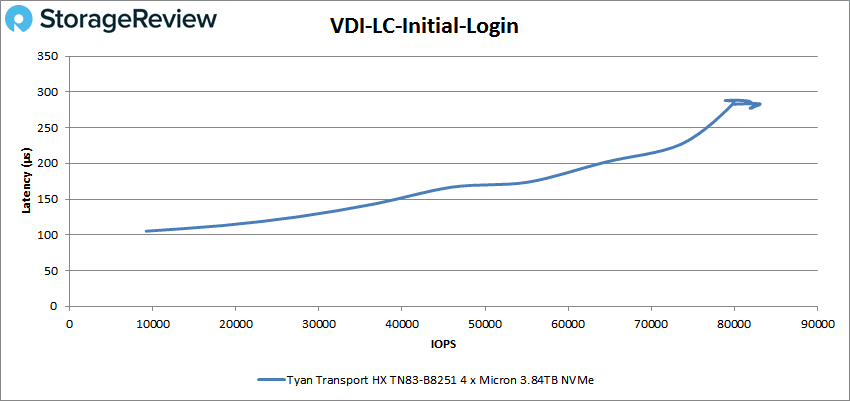
Finally, VDI LC Monday Login had a peak of 96,535 IOPS with a latency of just 481.4µs, with a bit of uneven performance at the end.
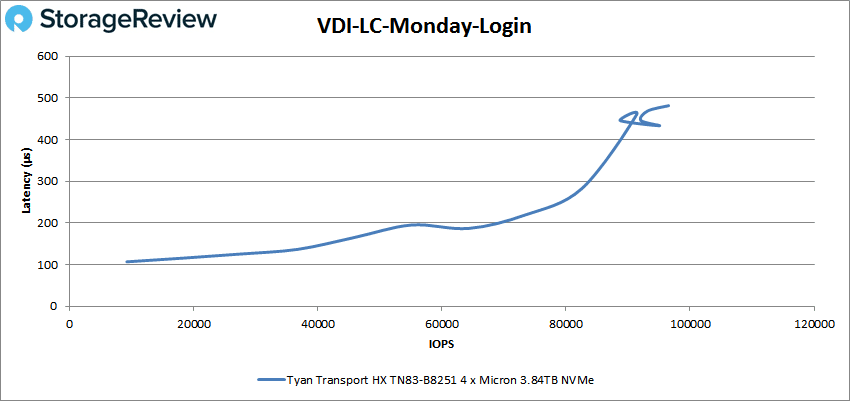
Conclusion
Because it has limited system-cooling abilities, the TYAN TN83-B8251 unfortunately only supports CPUs with lower thermal design power, including dual-socket AMD EPYC 7002 CPUs. This GPU-focused build also comes at a cost of storage, as the server features a 3.5″ build at the front of the chassis limiting it to eight drives. Though this isn’t too big of a deal for many (you still get a good amount of storage using HDDs, in addition to good performance with the U.2 NVMe drives), it will certainly curb organizations that require dense storage for their servers. It also would have been nice if they added a couple of internal M.2 slots by CPUs. That said, TYAN’s design choices are certainly understandable due to its intended use case.

With SQL we saw 729K IOPS for SQL workload, 722K for SQL 90-10, and 633K IOPS for SQL 80-20. In Oracle, the server hit 619K IOPS, 601K IOPS for Oracle 90-10, and 557K IOPS for Oracle 80-20. For our VDI cloned test, the TYAN server had Full Clone results of 587K IOPS boot, 160K IOPS Initial Login, and 149K IOPS Monday Login, while Linked Clone showed 291K IOPS for boot, 83K IOPS for Initial Login, and 97K IOPS for Monday Login.
Overall, the TYAN Transport HX TN83-B8251 is a very focused platform that pushes full steam ahead with GPUs. The server is good at what it does, offering strong support for applications that can take advantage of a dense GPU box.




 Amazon
Amazon